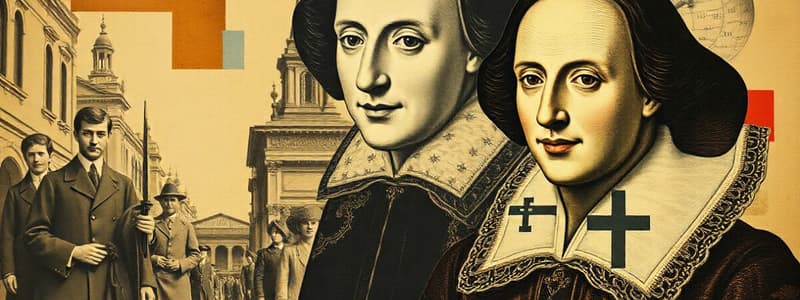Podcast
Questions and Answers
Which playwright is NOT associated with the Elizabethan Period?
Which playwright is NOT associated with the Elizabethan Period?
- Christopher Marlowe
- William Shakespeare
- Ben Jonson
- Charles Dickens (correct)
Most people during the Elizabethan Period were literate and could read and write.
Most people during the Elizabethan Period were literate and could read and write.
False (B)
What is the central theme of Romeo and Juliet in Act 1, Scene 1?
What is the central theme of Romeo and Juliet in Act 1, Scene 1?
Love, Violence, Family
William Shakespeare was born on April 23, ______.
William Shakespeare was born on April 23, ______.
Match the literary elements with their descriptions:
Match the literary elements with their descriptions:
What type of entertainment was common during the Elizabethan Period?
What type of entertainment was common during the Elizabethan Period?
Catholicism saw a decline during the Elizabethan Period.
Catholicism saw a decline during the Elizabethan Period.
Who is considered the greatest English playwright of all time?
Who is considered the greatest English playwright of all time?
Which of the following is an example of figurative language?
Which of the following is an example of figurative language?
Hyperbole is used to make something sound worse than it really is.
Hyperbole is used to make something sound worse than it really is.
What is the primary function of an essay?
What is the primary function of an essay?
A ________ is a literary device that compares two different things using 'is'.
A ________ is a literary device that compares two different things using 'is'.
Match the following literary devices with their definitions:
Match the following literary devices with their definitions:
Which of the following is NOT a type of run-on sentence?
Which of the following is NOT a type of run-on sentence?
The audience of an essay refers to the author's personal opinions.
The audience of an essay refers to the author's personal opinions.
What is a thesis in the context of an essay?
What is a thesis in the context of an essay?
Flashcards are hidden until you start studying
Study Notes
Overview of the Elizabethan Period (1558-1603)
- Named after Queen Elizabeth I, a time of prominent literary production.
- Notable playwrights include Christopher Marlowe, Ben Jonson, and William Shakespeare.
- Living conditions improved with greater luxury in clothing and food.
- Entertainment included storytelling, music, and dancing.
- Majority of the population was illiterate.
- Religion played a crucial role in governance; Catholicism gained influence amid a decline in Christianity, partly due to the Bubonic Plague.
William Shakespeare
- Born on April 23, 1564, in Warwickshire, England; died on the same date in 1616.
- Emerged from a middle-class background.
- Recognized as the greatest English playwright, with an enduring legacy of 7 published plays, 154 sonnets, and 5 narrative poems.
- "Romeo and Juliet" believed to have been written between 1591 and 1595.
Elements of Drama
- Plot: Overall storyline, consisting of initial incident, rising action, climax, falling action, and denouement.
- Theme: Central ideas conveyed in plays; for example, themes of love, violence, and family in "Romeo and Juliet."
- Characters: Propel narrative forward, showcasing different traits and complexities.
- Dialogue: Conversations between characters vital for progression and engagement.
- Music or Rhythm: Contributes to the emotional delivery by the actors.
- Spectacle: Visual representation that enhances the storytelling experience.
Technical Elements of Drama
- Scenery: Depicts various settings throughout the play.
- Costumes: Reflect characters’ social status and personality.
- Props: Objects that create the environment for characters' interactions.
Performance Elements
- Acting: Involves facial expressions, voice modulation, and gestures to portray roles convincingly.
- Character Motivation: Reasons behind characters' actions and behaviors.
- Character Analysis: Examination of all aspects of a character's portrayal.
- Empathy: Ability of actors to connect with characters, fostering audience identification.
Figures of Speech
- Deviate from literal meanings to enhance expression; includes:
- Simile: Comparison using "like" or "as."
- Metaphor: Direct comparison using "is."
- Hyperbole: Exaggerated statements for effect.
- Apostrophe: Addressing the absent.
- Assonance: Repetition of vowel sounds.
- Onomatopoeia: Imitation of natural sounds.
- Personification: Attribution of human characteristics to non-human entities.
Run-On Sentences
- Occur when two or more independent clauses are not properly joined.
- Types:
- Comma Splice: E.g., "You were Romeo, you were throwing pebbles."
- Using Transitional Devices: E.g., "You were Romeo, moreover, you were throwing pebbles."
- Fused Sentence: E.g., "We went to get ice cream I got a chocolate sundae."
- Fixing Techniques:
- Replace commas with semicolons.
- Add coordinating conjunctions.
- Convert to separate sentences using periods or subordinating conjunctions.
Essay Writing
- Definition: Nonfiction literary work in prose, composed of one or more paragraphs.
- Written by an Essayist, focusing on real-world topics.
- Topic: Starting point for writing;
- Thesis: Author's viewpoint on the topic, being factual yet arguable.
- Purpose: The writer's intention behind the essay.
- Tone: Author's attitude towards the topic.
- Language: Tailored to topic, purpose, and audience.
- Structure: Standard essays typically include an introduction, body, and conclusion.
- Audience: The targeted readership for the essay.
Parts of an Essay
- Title: Hints at the content or subject.
- Introduction: Introduces the main idea and sets the stage for discussion.
Studying That Suits You
Use AI to generate personalized quizzes and flashcards to suit your learning preferences.




